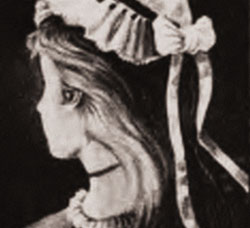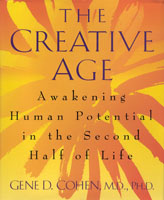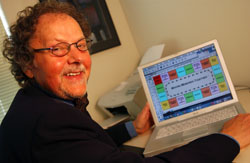The Myth of Aging
Professor Gene Cohen shows that older persons are not “over
the hill.” They are truly “55 or better.”
By Laura Ewald

|

An anonymous German postcard from the late 1800s depicts a perceptual
illusion in which the viewer can see either a young woman or an old
woman. Through his research on gerontology and creativity, Professor
Gene Cohen reminds us that aging, too, is a matter of perception.
|
"Wicked, weird, or weak”—from children’s
fairy tales to TV sitcoms, that is the stereotypical
portrayal of aging, says Gene Cohen, professor of health
care sciences and of psychiatry. Through founding and
directing GW’s Center on Aging, Health, and Humanities,
Cohen deconstructs this mindset and disseminates the
truth about today’s older adults: They are living
longer, are more educated and active, and have better
care options than ever before. And it is a challenge
for the American public, government, health care providers,
media, and businesses to keep up with them.
Through his work at the center and his book on how creativity
unlocks the potential of the body and mind, Cohen is
the driving force behind a widespread reevaluation of
the aging process.
Cohen became involved in gerontology while training
in psychiatry at Georgetown in the early 1970s. “I
started with the unfounded mindset that older adults
were tired, forgetful, and reaching the end of their
journey,” Cohen says. “What I found was that
they were improving through the medical and social interventions
they were receiving, that they were grateful for and
responsive to care, and that they had a great deal of
life to live. It was a brand new field, and there was
a dramatic change as the public, the medical field, and
the older adults themselves had to adapt.”
From 1973 to 1975, Cohen was stationed at the National
Institutes of Health during military service for the
Vietnam War. At NIH, he was asked to head a program for
the elderly. That program turned into the National Institute
on Mental Health’s Center on Aging. After his service
officially ended, he stayed on at NIH, where he remained
as director of the center for 13 years.
The existence of the Center on Aging helped to bring
about major changes in how people view aging, Cohen says.
Instead of viewing older adults as a group doomed to
lose their good hearing, eyesight, and memory, “We
began to see older adults as a thriving population that
happens to be affected by age-associated problems,” he
says. “These are problems that can happen when
you age, not things that will happen because you age.”
This change in mind set was profound. “It was
an exciting time when we began to see that we could treat
these problems and improve their quality of life,” Cohen
says. “It wasn’t a matter of the inevitable
anymore; it was a matter of the possible.”
In 1994, after serving three years as acting director
of the National Institute on Aging, Cohen left the government
to join GW’s faculty and founded the University’s
Center on Aging, Health, & Humanities. “GW
is an ideal location to influence social policy, a critical
aspect of our work at the center,” Cohen says.
The center also conducts sponsored research on aging,
with the goal of improving the quality of life for older
adults and their families. Projects are led by an interdisciplinary
group of GW scientists and faculty members; for example,
GW’s oral history and art therapy professors have
worked on special tasks with the medical staff.
The center’s research emphasizes creative projects
and intergenerational activities, from crossword puzzles
to family quilting projects. Improved family visits,
greater mobility, and a more positive mental outlook
are some of the benefits.
Cohen and his approach of promoting creative endeavors
to delay the onset of Alzheimer’s disease have
been covered widely in the media. According to the Alzheimer’s
Association, about 4.5 million Americans have the disease,
a number that has more than doubled since 1980 and is
expected to grow to an excess of 11 million people by
2050. The Alzheimer’s Association says that finding
a treatment that could delay onset by five years might
reduce the number of individuals with the disease by
nearly 50 percent after 50 years.
It was during the late 1990s that Cohen and colleague
Barbara Soniat began noticing in their research that
creative activities may help delay Alzheimers. In 1997,
they founded the Creativity Discovery Corps to formally
examine the connection. Based at the Iona Senior Services
facility in Washington, the corps and partner organizations
such as the National Endowment for the Arts help older
adults engage in community-based arts programs and note
the direct impact on social skills, mobility, physical
health, and overall good mental health.
They have found that sleep and mood disorders can be
alleviated by stimulating the brain; that vocabulary
expands well into the 80s among people who continually
challenge themselves through reading, writing, and
word games; and that an active lifestyle can boost the
immune system.
 A few years later, Cohen wrote The
Creative Age: Awakening Human Potential in the Second
Half of Life (Perennial
Currents, 2001), which put him and the center’s
research in the national spotlight, as the book sparked
more than 600 media queries. The subject also became
the main focus of a study that will guide the White House
Conference on Aging in December. A few years later, Cohen wrote The
Creative Age: Awakening Human Potential in the Second
Half of Life (Perennial
Currents, 2001), which put him and the center’s
research in the national spotlight, as the book sparked
more than 600 media queries. The subject also became
the main focus of a study that will guide the White House
Conference on Aging in December.
Cohen says that there are more adults over the age of
65 in the United States today than the entire population
of Canada. That figure will grow once the Baby Boomers
reach their senior years. Because today’s older
adults are more educated, are more civically active,
and have more influence than ever before, they have “markedly
and deservedly more influence and public presence than
older adults have ever enjoyed in the past,” and
it is a trend that will continue, he says. Markets such
as housing are already being affected, as evidenced by
the boom in retirement housing options, from “55
or better” retirement communities, to “age
in place” homes.
Cohen refers to these resulting economic, medical, social,
and governmental changes as a new “landscape for
aging in America.” It is one in which “we
need to make sure that we as a nation are investing enough
research, time, and funding into caring for these citizens
and taking advantage of what they have to offer. Older
adults are an undertapped national resource,” he
says.
From raising grandchildren to volunteering, older adults
are increasingly an integral part of the American fabric
of society and family. “Especially with today’s
single-parent families, grandparents and older adults
are caring for society like never before,” Cohen
says.
“Intergenerational communication helps everyone’s
personal growth,” he adds. “For older adults,
it exposes them to the full range of human interaction
and helps them stay in touch with the changing world.
For young people, especially children, it helps expand
their understanding and perception of themselves as ‘helping
individuals,’ and this interaction gives them a
new respect for every stage of life.”

|

Gene Cohen in his office at the Iona Senior Services center in Washington
with the therapeutic board game he developed for older adults who
have Alzheimer’s disease. Using biographical flash cards to
spark memories, the game helps patients reconnect with their families.
|
The flagship project of the GW center is treating Alzheimer’s
disease through what is called “biographical interventions.” Using
photos and images coupled with running commentary, families
and staff members create video biographies that spark
memories and emotional response in patients with Alzheimer’s
disease. Cohen and his staff also developed a therapeutic
board game that includes biographical flash cards—images
and names of grandchildren, places, and pets with accompanying
questions—created with help from family and friends.
Family visits also help younger generations improve
their perception of older adults: Cohen says studies
show that while the majority of American children have
a positive view of the older adults in their family,
they have a negative overall view of aging. Cohen teamed
with the Association for Library Service to Children
of the American Library Association to create and disseminate
a list of books geared to children going into kindergarten
through sixth grade that portray older adults in a positive
light.
In preparation for the White House Conference on Aging
this December, Cohen and researchers from across the
nation are meeting at officially designated mini “feeder” conferences
to discuss these and other studies, the needs of older
adults, technology, and other topics. They will make
recommendations to the president and Congress on how
to continue to better serve the population. The conference
is held every 10 years and has been a catalyst for important
aging programs such as Medicare and Medicaid, the Older
Americans Act, Supplemental Security Income, and the
programs on aging at NIH.
Documentary Focuses on Aging
The 77 million members of the Baby Boomer generation
are no strangers to revolution; challenging the
status quo was the hallmark of their coming-of-age.
They’re taking a similar approach to retirement.
“Boomers simply don’t identify with
the aging process. In our minds, we’re still
the revolutionaries who came of age in the 1960s
and ’70s,” says assistant research
professor of history Nina Gilden Seavey.
Seavey is an Emmy Award winning filmmaker and
director of GW’s Documentary Center. In her
newest production, The Open
Road: America Looks at Aging, Seavey profiles 14 individuals and their
varying approaches to aging. The film premieres
in July on American Public Television. It includes
commentary from professor Gene Cohen, director
of GW’s Center on Aging, Health, and Humanities.
Research for the film took Seavey across the country
to find individuals who embodied six major issues
Boomers will have to face, topics such as fear,
financial difficulties, and pursuing new hobbies
and opportunities.
“There’s no such thing for Boomers
as ‘one size fits all,’ and it’s
not a given that every person will be able to enjoy
their retirement. Aging will not be a linear process,” Seavey
says.
She highlights societal issues relating to aging
populations as well. “I don’t think
those responsible for our social institutions and
public policy related to older Americans have even
begun to recognize the huge demographic transformation
about to take place, or have any understanding
of what it means,” Seavy says.
The film will be part of a nationwide dialogue
that will include 10 town meetings, news articles,
and the creation of a model communities program. |
|